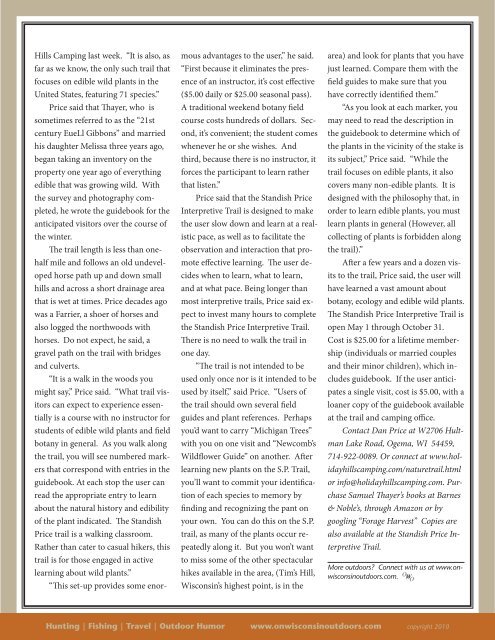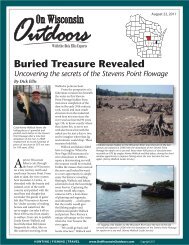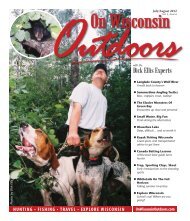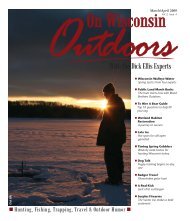A Forager's Paradise Interpretive trail focuses on edible wild plants
A Forager's Paradise Interpretive trail focuses on edible wild plants
A Forager's Paradise Interpretive trail focuses on edible wild plants
You also want an ePaper? Increase the reach of your titles
YUMPU automatically turns print PDFs into web optimized ePapers that Google loves.
Hills Camping last week. “It is also, as<br />
far as we know, the <strong>on</strong>ly such <str<strong>on</strong>g>trail</str<strong>on</strong>g> that<br />
<str<strong>on</strong>g>focuses</str<strong>on</strong>g> <strong>on</strong> <strong>edible</strong> <strong>wild</strong> <strong>plants</strong> in the<br />
United States, featuring 71 species.”<br />
Price said that Thayer, who is<br />
sometimes referred to as the “21st<br />
century EueLl Gibb<strong>on</strong>s” and married<br />
his daughter Melissa three years ago,<br />
began taking an inventory <strong>on</strong> the<br />
property <strong>on</strong>e year ago of everything<br />
<strong>edible</strong> that was growing <strong>wild</strong>. With<br />
the survey and photography completed,<br />
he wrote the guidebook for the<br />
anticipated visitors over the course of<br />
the winter.<br />
The <str<strong>on</strong>g>trail</str<strong>on</strong>g> length is less than <strong>on</strong>ehalf<br />
mile and follows an old undeveloped<br />
horse path up and down small<br />
hills and across a short drainage area<br />
that is wet at times. Price decades ago<br />
was a Farrier, a shoer of horses and<br />
also logged the northwoods with<br />
horses. Do not expect, he said, a<br />
gravel path <strong>on</strong> the <str<strong>on</strong>g>trail</str<strong>on</strong>g> with bridges<br />
and culverts.<br />
“It is a walk in the woods you<br />
might say,” Price said. “What <str<strong>on</strong>g>trail</str<strong>on</strong>g> visitors<br />
can expect to experience essentially<br />
is a course with no instructor for<br />
students of <strong>edible</strong> <strong>wild</strong> <strong>plants</strong> and field<br />
botany in general. As you walk al<strong>on</strong>g<br />
the <str<strong>on</strong>g>trail</str<strong>on</strong>g>, you will see numbered markers<br />
that corresp<strong>on</strong>d with entries in the<br />
guidebook. At each stop the user can<br />
read the appropriate entry to learn<br />
about the natural history and edibility<br />
of the plant indicated. The Standish<br />
Price <str<strong>on</strong>g>trail</str<strong>on</strong>g> is a walking classroom.<br />
Rather than cater to casual hikers, this<br />
<str<strong>on</strong>g>trail</str<strong>on</strong>g> is for those engaged in active<br />
learning about <strong>wild</strong> <strong>plants</strong>.”<br />
“This set-up provides some enor-<br />
mous advantages to the user,” he said.<br />
“First because it eliminates the presence<br />
of an instructor, it’s cost effective<br />
($5.00 daily or $25.00 seas<strong>on</strong>al pass).<br />
A traditi<strong>on</strong>al weekend botany field<br />
course costs hundreds of dollars. Sec<strong>on</strong>d,<br />
it’s c<strong>on</strong>venient; the student comes<br />
whenever he or she wishes. And<br />
third, because there is no instructor, it<br />
forces the participant to learn rather<br />
that listen.”<br />
Price said that the Standish Price<br />
<str<strong>on</strong>g>Interpretive</str<strong>on</strong>g> Trail is designed to make<br />
the user slow down and learn at a realistic<br />
pace, as well as to facilitate the<br />
observati<strong>on</strong> and interacti<strong>on</strong> that promote<br />
effective learning. The user decides<br />
when to learn, what to learn,<br />
and at what pace. Being l<strong>on</strong>ger than<br />
most interpretive <str<strong>on</strong>g>trail</str<strong>on</strong>g>s, Price said expect<br />
to invest many hours to complete<br />
the Standish Price <str<strong>on</strong>g>Interpretive</str<strong>on</strong>g> Trail.<br />
There is no need to walk the <str<strong>on</strong>g>trail</str<strong>on</strong>g> in<br />
<strong>on</strong>e day.<br />
“The <str<strong>on</strong>g>trail</str<strong>on</strong>g> is not intended to be<br />
used <strong>on</strong>ly <strong>on</strong>ce nor is it intended to be<br />
used by itself,” said Price. “Users of<br />
the <str<strong>on</strong>g>trail</str<strong>on</strong>g> should own several field<br />
guides and plant references. Perhaps<br />
you’d want to carry “Michigan Trees”<br />
with you <strong>on</strong> <strong>on</strong>e visit and “Newcomb’s<br />
Wildflower Guide” <strong>on</strong> another. After<br />
learning new <strong>plants</strong> <strong>on</strong> the S.P. Trail,<br />
you’ll want to commit your identificati<strong>on</strong><br />
of each species to memory by<br />
finding and recognizing the pant <strong>on</strong><br />
your own. You can do this <strong>on</strong> the S.P.<br />
<str<strong>on</strong>g>trail</str<strong>on</strong>g>, as many of the <strong>plants</strong> occur repeatedly<br />
al<strong>on</strong>g it. But you w<strong>on</strong>’t want<br />
to miss some of the other spectacular<br />
hikes available in the area, (Tim’s Hill,<br />
Wisc<strong>on</strong>sin’s highest point, is in the<br />
area) and look for <strong>plants</strong> that you have<br />
just learned. Compare them with the<br />
field guides to make sure that you<br />
have correctly identified them.”<br />
“As you look at each marker, you<br />
may need to read the descripti<strong>on</strong> in<br />
the guidebook to determine which of<br />
the <strong>plants</strong> in the vicinity of the stake is<br />
its subject,” Price said. “While the<br />
<str<strong>on</strong>g>trail</str<strong>on</strong>g> <str<strong>on</strong>g>focuses</str<strong>on</strong>g> <strong>on</strong> <strong>edible</strong> <strong>plants</strong>, it also<br />
covers many n<strong>on</strong>-<strong>edible</strong> <strong>plants</strong>. It is<br />
designed with the philosophy that, in<br />
order to learn <strong>edible</strong> <strong>plants</strong>, you must<br />
learn <strong>plants</strong> in general (However, all<br />
collecting of <strong>plants</strong> is forbidden al<strong>on</strong>g<br />
the <str<strong>on</strong>g>trail</str<strong>on</strong>g>).”<br />
After a few years and a dozen visits<br />
to the <str<strong>on</strong>g>trail</str<strong>on</strong>g>, Price said, the user will<br />
have learned a vast amount about<br />
botany, ecology and <strong>edible</strong> <strong>wild</strong> <strong>plants</strong>.<br />
The Standish Price <str<strong>on</strong>g>Interpretive</str<strong>on</strong>g> Trail is<br />
open May 1 through October 31.<br />
Cost is $25.00 for a lifetime membership<br />
(individuals or married couples<br />
and their minor children), which includes<br />
guidebook. If the user anticipates<br />
a single visit, cost is $5.00, with a<br />
loaner copy of the guidebook available<br />
at the <str<strong>on</strong>g>trail</str<strong>on</strong>g> and camping office.<br />
C<strong>on</strong>tact Dan Price at W2706 Hultman<br />
Lake Road, Ogema, WI 54459,<br />
714-922-0089. Or c<strong>on</strong>nect at www.holidayhillscamping.com/nature<str<strong>on</strong>g>trail</str<strong>on</strong>g>.html<br />
or info@holidayhillscamping.com. Purchase<br />
Samuel Thayer’s books at Barnes<br />
& Noble’s, through Amaz<strong>on</strong> or by<br />
googling “Forage Harvest” Copies are<br />
also available at the Standish Price <str<strong>on</strong>g>Interpretive</str<strong>on</strong>g><br />
Trail.<br />
More outdoors? C<strong>on</strong>nect with us at www.<strong>on</strong>wisc<strong>on</strong>sinoutdoors.com.<br />
O W O<br />
Hunting | Fishing | Travel | Outdoor Humor www.<strong>on</strong>wisc<strong>on</strong>sinoutdoors.com copyright 2010







